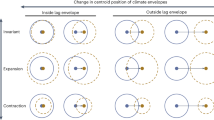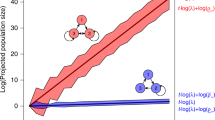‘A vile weed.’ (Rumex acetosella, 1861).
‘A very bad weed.’ (Salsola tragus, 1937).
‘…this horrendous weed grows in solid stands by the 1000s…’ (Alliaria petiolata, 1997).
–Comments by collectors of Wisconsin herbarium specimens.
Abstract
There are often lag phases in plant invasions, seemingly dormant periods between arrival in a new range and rapid population growth. Lags impede prioritization of invasive-species control efforts: when eradication is most feasible, it is often unclear whether a species is benign or a potentially harmful “sleeper weed.” I used herbarium records to estimate lag phases for invasive or potentially invasive plant species in three regions of the upper Midwest. I tested whether factors related to species’ invasion epidemiology, traits, or the habitats they invade were correlated with lag lengths. From an initial pool of 151 species, there were sufficient records to test for lags in 76 for northern Wisconsin, 90 for southern Wisconsin, and 91 for the southern Lake Michigan region. Lags were identified in 77% (197) of these 257 datasets and ranged from 3–140 years with a mean of 47.3 ± 34.6 (SD). Lags differed by native range, introduction pathway, growth form and habit, dispersal mode, flowering phenology, pollination mode for a subset of species, and breadth, light availability, and water availability of invaded habitats. However, estimated lags were highly variable and tested factors did not have strong explanatory power. Exotic species comprised an increasing proportion of total herbarium records. Of the species with known introduction pathways, 85% were intentionally introduced, mainly as ornamentals. The long durations, high variability, and low predictability of lags, along with human culpability for an increasingly non-native flora, support a cautious approach to species introductions.




Similar content being viewed by others
References
Aikio S, Duncan RP, Hulme PE (2010) Lag-phases in alien plant invasions: separating the facts from the artefacts. Oikos 119:370–378
Baker HG (1974) The evolution of weeds. Annu Rev Ecol Syst 5:1–24
Bartuszevige AM, Gorchov DL (2006) Avian seed dispersal of an invasive shrub. Biol Invasions 8:1013–1022
Burnham KP, Anderson DR (2002) Model selection and multimodel inference: a practical information-theoretic approach. Springer Science + Business Media, Inc., New York
Burns JH, Ashman TL, Steets JA, Harmon-Threatt A, Knight TM (2011) A phylogenetically controlled analysis of the roles of reproductive traits in plant invasions. Oecologia 166:1009–1017
Cadotte MW, Mai DV, Jantz S, Collins MD, Keele M, Drake JA (2006) On testing the competition colonization tradeoff in a multispecies assemblage. Am Nat 168:704–709
Callaway JC, Josselyn MN (1992) The introduction and spread of smooth cordgrass (Spartina alterniflora) in south San Francisco Bay. Estuaries 15:218–226
Callaway RM, Ridenour WM (2004) Novel weapons: invasive success and the evolution of increased competitive ability. Front Ecol Environ 2:436–443
CBG (2010) Invasive plants in the Chicago region. http://www.chicagobotanic.org/research/conservation/invasive/chicago/. Chicago Botanic Garden
City of Chicago (2009) Invasive species control: rules and regulations. http://www.cityofchicago.org/city/en/depts/doe/supp_info/invasive_species.html. City of Chicago Department of Environment
Colautti RI, MacIsaac HJ (2004) A neutral terminology to define ‘invasive’ species. Divers Distrib 10:135–141
Crawley MJ, Harvey PH, Purvis A (1996) Comparative ecology of the native and alien floras of the British Isles. Philos Trans R Soc Lond B Biol Sci 351:1251–1259
Crooks JA (2005) Lag times and exotic species: the ecology and management of biological invasions in slow-motion. Ecoscience 12:316–329
Cunningham DC, Woldendorp G, Burgess MB, Barry SC (2003) Prioritising sleeper weeds for eradication: selection of species based on potential impacts on agriculture and feasibility of eradication. Bureau of Rural Sciences, Canberra
Curtis JT (1959) The vegetation of Wisconsin. The University of Wisconsin Press, Madison
Daehler CC (2003) Performance comparisons of co-occurring native and alien invasive plants: implications for conservation and restoration. Annu Rev Ecol Evol Syst 34:183–211
de Jong TJ, Klinkhamer P (2005) Evolutionary ecology of plant reproductive strategies. Cambridge University Press, Cambridge
Dirr MA (2009) Manual of woody landscape plants. Stipes Publishing L.L.C., Champaign
Dynesius M, Jansson R (2000) Evolutionary consequences of changes in species’ geographical distributions driven by Milankovitch climate oscillations. Proc Natl Acad Sci USA 97:9115–9120
Ellstrand NC, Schierenbeck KA (2000) Hybridization as a stimulus for the evolution of invasiveness in plants? Proc Natl Acad Sci USA 97:7043–7050
Essl F, Dullinger S, Rabitsch W, Hulme PE, Hülber K, Jarošík V, Kleinbauer I, Krausmann F, Kühn I, Nentwig W, Vilà M, Genovesi P, Gherardi F, Desprez-Loustau M-L, Roques A, Pyšek P (2011) Socioeconomic legacy yields an invasion debt. Proc Natl Acad Sci USA 108:203–207
Feeley KJ, Silman MR (2011) The data void in modeling current and future distributions of tropical species. Global Change Biol 17:626–630
Fuentes N, Ugarte E, Kuhn I, Klotz S (2008) Alien plants in Chile: inferring invasion periods from herbarium records. Biol Invasions 10:649–657
Gerlach JD, Rice KJ (2003) Testing life history correlates of invasiveness using congeneric plant species. Ecol Appl 13:167–179
Grijalva E, Kerr D, Olofson P (2008) Invasive Spartina control plan for the San Francisco Estuary: 2008–2010 control seasons. Olofson Environmental, Inc., Berkeley
Grime JP (1979) Plant strategies and vegetation processes. John Wiley & Sons, New York
Haney A, Apfelbaum SI (1995) Characterization of Midwestern oak savannas. In: Stearns F, Holland K (eds) Proceedings of the 1993 Midwest Oak Savanna Conference, U.S. Environmental Protection Agency. Northeastern Illinois University, Chicago
IPAW (2003) IPAW working list of the invasive plants of Wisconsin. http://www.ipaw.org/list/index.aspx. Invasive Plants Association of Wisconsin
Jefferson L, Havens K, Ault J (2004) Implementing invasive screening procedures: the Chicago Botanic Garden model. Weed Technol 18:1434–1440
Levin LA, Neira C, Grosholz ED (2006) Invasive cordgrass modifies wetland trophic function. Ecol 87:419–432
Lloret F, Medail F, Brundu G, Camarda I, Moragues E, Rita J, Lambdon P, Hulme PE (2005) Species attributes and invasion success by alien plants on Mediterranean islands. J Ecol 93:512–520
Mack RN, Simberloff D, Lonsdale WM, Evans H, Clout M, Bazzaz FA (2000) Biotic invasions: causes, epidemiology, global consequences, and control. Ecol Appl 10:689–710
McCay TS, McCay DH, Czajka JL (2009) Deposition of exotic bird-dispersed seeds into three habitats of a fragmented landscape in the northeastern United States. Plant Ecol 203:59–67
Merritt DM, Wohl EE (2002) Processes governing hydrochory along rivers: hydraulics, hydrology, and dispersal phenology. Ecol Appl 12:1071–1087
Mihulka S, Pyšek P (2001) Invasion history of Oenothera congeners in Europe: a comparative study of spreading rates in the last 200 years. J Biogeogr 28:597–609
Miller RG (1997) Survival analysis. Wiley, New York
Moffitt LJ, Osteen CD (2006) Prioritizing invasive species threats under uncertainty. Agric Resour Econ Rev 41:41–51
NIWL (2010) New invaders watch list: early detection and rapid response network. http://ctap.inhs.uiuc.edu/newinvaders/target_species.aspx. New Invaders Watch List
Nowacki GJ, Abrams MD (2008) The demise of fire and “Mesophication” of forests in the eastern United States. Bioscience 58:123–138
Pimentel D, Zuniga R, Morrison D (2005) Update on the environmental and economic costs associated with alien-invasive species in the United States. Ecol Econ 52:273–288
Pyšek P, Hulme PE (2005) Spatio-temporal dynamics of plant invasions: linking pattern to process. Ecoscience 12:302–315
Pysek P, Richardson DM, Pergl J, Jarosik V, Sixtova Z, Weber E (2008) Geographical and taxonomic biases in invasion ecology. Trends Ecol Evol 23:237–244
R Development Core Team (2009) R: a language and environment for statistical computing. R Foundation for Statistical Computing, Vienna
Radford IJ, Cousens RD (2000) Invasiveness and comparative life-history traits of exotic and indigenous Senecio species in Australia. Oecologia 125:531–542
Reichard SH, Hamilton CW (1997) Predicting invasions of woody plants introduced into North America. Conserv Biol 11:193–203
Reichard SH, White P (2001) Horticulture as a pathway of invasive plant introductions in the United States. Bioscience 51:103–113
Richardson DM, Allsopp N, D’Antonio CM, Milton SJ, Rejmanek M (2000) Plant invasions—the role of mutualisms. Biol Rev Camb Philos Soc 75:65–93
Ricketts TH, Dinerstein E, Olson DM, Loucks CJ, Eichbaum W, DellaSala D, Kavanagh K, Hedao P, Hurley PT, Carney KM, Abell R, Walters S (1999) Terrestrial ecoregions of North America: a conservation assessment. Island Press, Washington
Robbirt KM, Davy AJ, Hutchings MJ, Roberts DL (2011) Validation of biological collections as a source of phenological data for use in climate change studies: a case study with the orchid Ophrys sphegodes. J Ecol 99:235–241
Simberloff D (2006) Risk assessments, blacklists, and white lists for introduced species: are predictions good enough to be useful? Agric Resour Econ Rev 35:1–10
Simberloff D (2011) Non-natives: 141 scientists object. Nature 475:36
Therneau TM, Atkinson B (2010) Rpart: recursive partitioning. R package version 3:1–46
Therneau T, Lumley T (2009) Survival: survival analysis, including penalised likelihood. R package version 2:35–38
Thompson K, Hodgson JG, Rich TCG (1995) Native and alien invasive plants: more of the same? Ecography 18:390–402
Urban DL (2002) Classification and regression trees. In: McCune B, Grace JB (eds) Analysis of ecological communities. MjM Software Design, Gleneden Beach, pp 222–232
Venables WN, Ripley BD (2002) Modern applied statistics with S. Springer, New York
Vitousek PM, Dantonio CM, Loope LL, Rejmanek M, Westbrooks R (1997) Introduced species: a significant component of human-caused global change. N Z J Ecol 21:1–16
von Bertalanffy L (1938) A quantitative theory of organic growth. Hum Biol 10:181–213
vPlants (2010) vPlants: a virtual herbarium of the Chicago region. http://www.vplants.org/index.html. The vPlants Project
Widrlechner MP, Iles JK (2002) A geographic assessment of the risk of naturalization of non-native woody plants in Iowa. J Environ Hort 20:47–56
Widrlechner MP, Thompson JR, Kapler EJ, Kordecki K, Dixon PM, Gates G (2009) A test of four models to predict the risk of naturalization of non-native woody plants in the Chicago region. J Environ Hort 27:241–250
Wiegmann SM, Waller DM (2006) Fifty years of change in northern upland forest understories: identity and traits of “winner” and “loser” plant species. Biol Conserv 129:109–123
Williamson M, Fitter A (1996) The varying success of invaders. Ecol 77:1661–1666
Wisflora (2010) Wisflora: Wisconsin vascular plant species. http://www.botany.wisc.edu/wisflora/. Wisconsin State Herbarium
Zedler JB, Kercher S (2004) Causes and consequences of invasive plants in wetlands: opportunities, opportunists, and outcomes. Crit Rev Plant Sci 23:431–452
Acknowledgments
I thank the institutions and people responsible for the Wisflora and vPlants online herbaria, particularly Merel Black and Andrew Hipp who were generous with data and their time. Katrina Navoa compiled species information; Stuart Wagenius provided statistical advice and help with R programming; Kay Havens, Richard Olsen, and Jim Steffen provided insights on various aspects of the species and factors investigated. The comments of Anibal Pauchard and two anonymous reviewers greatly improved the manuscript. Lastly, I thank the countless individuals whose collecting and processing of specimens enabled this analysis.
Author information
Authors and Affiliations
Corresponding author
Electronic supplementary material
Below is the link to the electronic supplementary material.
Rights and permissions
About this article
Cite this article
Larkin, D.J. Lengths and correlates of lag phases in upper-Midwest plant invasions. Biol Invasions 14, 827–838 (2012). https://doi.org/10.1007/s10530-011-0119-3
Received:
Accepted:
Published:
Issue Date:
DOI: https://doi.org/10.1007/s10530-011-0119-3




